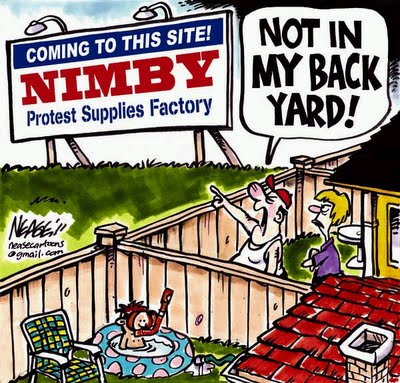Not in my back yard syndrome

NIMBY (also NIMBYism, NIMBY syndrome) is an acronym for "Not In My Back Yard".[2] The term describes people who act in their own interests to oppose nearby development of a technology or service from which they benefit and would otherwise support (this is related to NIMTOO - not in my term of office, NIMEY - not in my election year, and NOPE - not on planet Earth). Often, opposition to new developments is unusually high from those who live nearest the proposed location. The NIMBY concept attempts to explain this phenomenon of low public acceptance to new development. Power plants and utilities are among the most affected, ranking 4th in a United States survey behind landfills, casinos, and quarries as the most unwanted project types in citizens' hometowns[3].
Developers sometimes use this term in a pejorative way to dismiss the concerns of those opposed to a project. For this reason, some academics have spoken out against using the word, stating that the NIMBY label oversimplifies a complex issue [4] [5]. While self-centered attitudes may play some role in local opposition to development, concerns may also arise over the planning process or other details of a project[6]. Existing opposition to controversial technologies (e.g. nuclear or coal power) may also be stirred up by the threat of local development.
Regardless of the reasons behind NIMBY attitudes, research shows that they are indeed held among some members of the Canadian public. In a 2007 poll, 15% of Ontario residents said: "I support nuclear-producted electricity, but only if the plant is not located in my province[7]." This opposition to local development despite general, abstract support for an idea is a clear example of so-called NIMBY attitudes in effect.
Even energy sources with strong general support are subject to local opposition. Wind power enjoys 85% national support in Canada overall[8], but wind turbine development is often unpopular with locals. Research has shown that NIMBY attitudes are primarily present during the planning stages of a project. In a 1994 survey, only 40% of UK residents near proposed wind farm sites supported the projects themselves, although 70% supported wind power development in general. The projects gained greater acceptance after they were completed, however, with 66% of residents showing support in a post-development survey[9].
NIMBY and the energy industry
The following table lists some examples of energy-related development projects which have experienced local opposition.
| Energy type | Location | Details | Current status |
|---|---|---|---|
| Hydroelectric power | Fort St. John, British Columbia | 1,100 MW hydroelectric dam proposed by BC Hydro[10]. | Under regulatory review. |
| Natural gas | Oakville, Ontario | A 900 MW natural gas-fired power plant to be built by TransCanada. | Cancelled in 2010[11]. |
| Nuclear power | Peace River, Alberta | Approval for a 4000 MW nuclear power plant sought by Bruce Power. | Cancelled in 2011[12]. |
| Wind power | Town of the Blue Mountains, Ontario | 49.5 MW wind farm proposed by Brookfield Power. | Cancelled in 2006[13]. |
References
- ↑ Cartoon by Steve Nease (2011). neasecartoons.com Used by permission granted in private communication with Steve Nease. Not in my back yard. [Cartoon].
- ↑ Miriam-Webster (2014). NIMBY [Online]. Available: http://www.merriam-webster.com/dictionary/nimby
- ↑ Saint Consulting Group (2011). The Saint Index: United States 2011 [Online]. Available: http://saintindex.info/support-opposition
- ↑ M. Wolsink, "Wind power implementation: The nature of public attitudes: Equity and fairness instead of ‘backyard motives’", Renewable and Sustainable Energy Reviews, vol. 11, pp. 1188–1207, 2007.
- ↑ K. Burningham, "Using the Language of NIMBY: A topic for research, not an activity for researchers", The International Journal of Justice and Sustainability, vol. 5, no. 1, pp. 55-67, 2000.
- ↑ D. van der Horst, "NIMBY or not? Exploring the relevance of location and the politics of voiced opinions in renewable energy siting controversies," Energy Policy, vol. 35, pp. 2705–2714, 2007.
- ↑ Canadian Nuclear Association (2007, July). Report: Canadian Views on Nuclear Energy – Ontario [Online]. Available: http://www.cna.ca/wp-content/uploads/Full_Report_July2007PPT.pdf
- ↑ Canadian Nuclear Association (2012, June). 2012 Public Opinion Research – National Nuclear Attitude Survey [Online]. Available: http://www.cna.ca/wp-content/uploads/2012NuclearAttitudeReport.pdf
- ↑ S. Krohn and S. Damborg, "On Public Attitudes Towards Wind Power," Renewable Energy, vol. 16, pp. 954-960, 1999.
- ↑ Globe and Mail (2013). BC Hydro faces widespread community opposition over dam [Online]. Available: http://www.theglobeandmail.com/news/british-columbia/bc-hydro-faces-widespread-community-opposition-over-dam/article15816152/
- ↑ Oakville. (n.d.) Proposed TransCanada Power Plant – Cancelled by the Province [Online]. Available: http://www.oakville.ca/environment/proposed-transcanada-power-plant.html
- ↑ CBC (2011, December 12). Bruce Power dropping Alberta nuclear plant proposal [Online]. Available: http://www.cbc.ca/news/canada/edmonton/bruce-power-dropping-alberta-nuclear-plant-proposal-1.1046668
- ↑ Brookfield Power (2006). Brookfield Power terminates Blue Highlands wind energy contract in the Town of the Blue Mountains [Online]. Available: http://brookfieldrenewable.com/content/2006/brookfield_power_terminates_blue_highlands_wind_en-30733.html

